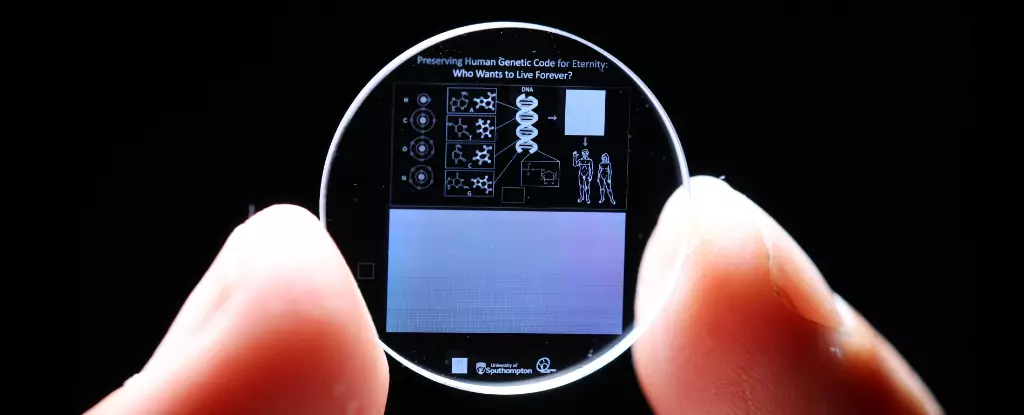As humanity grapples with the ephemeral nature of its achievements, a remarkable technology emerges to encapsulate our existence—5D memory crystals. This cutting-edge storage medium developed by researchers from the University of Southampton could one day serve as a significant cultural artifact, far into the future when Earth’s life forms have vanished. The fascinating capacity of this technology to encode and preserve data raises pressing questions about legacy, preservation, and the future of information technology.
5D memory crystals build upon earlier breakthroughs in data storage by utilizing femtosecond lasers to create nanoscale voids in silica. Unlike conventional data storage methods—such as magnetic tapes or CDs—which are subject to degradation, the unique arrangement of silicon and oxygen in these crystals makes them both robust and durable. They have been engineered to withstand extreme conditions, able to endure being frozen, heated to high temperatures, or subjected to physical stress while still retaining their data integrity.
In a noteworthy achievement, scientists successfully etched the complete modern human genome—approximately 3 billion base pairs—into a single memory crystal, resulting in a storage size of around 800 megabytes. This milestone demonstrates not only the immense potential of 5D technology but also highlights the importance of genomic data preservation for future generations. The storage medium is so durable that it has been archived in the Memory of Mankind’s repository located in an ancient salt mine in Austria, displaying an ambition to document and safeguard humanity’s genetic blueprint.
By partnering with Helixwork Technologies, researchers underscore a collaborative effort bridging biology with advanced material science, pointing toward a future in which genetic information could not only be archived but potentially resurrected. While the prospect of reconstructing extinct species remains speculative, it opens exciting avenues for future scientific exploration, suggesting that the information contained within these crystals could one day aid in understanding or recreating complex organisms.
A prominent question arises: in a billion years, how might future sentient beings interpret this intricate and cryptic data capsule? While retrieval and reconstruction of human DNA may seem like science fiction, it is grounded in existing scientific advances. Current biological techniques allow for the synthesis of genetic material to create viable organisms, albeit in simple life forms. The leap to mammalian or complex life restoration remains a daunting challenge; however, future developments in genetic engineering could yield astonishing advances.
The 5D memory crystal acts as a testament to humanity’s desire to leave a legacy, an ambition captured in this data repository. Researchers like Peter Kazansky highlight the importance of such technology, suggesting that it could pave the way for reintroduction efforts of lost species or even deepening our understanding of human evolution itself.
Humanity finds itself at a unique crossroads. As data proliferation continues to rise—projected to reach nearly 150 zettabytes in just a few years—the urgency for efficient, enduring storage solutions becomes increasingly paramount. The emergence of 5D memory crystals offers a compelling resolution to the quest for reliable data preservation. In a world inundated with digital content spanning social media to scientific databases, this technology’s potential to house vast amounts of information in a compact space while ensuring its longevity is invaluable.
The benefits extend beyond mere archival; they also encompass low-energy consumption costs, presenting a sustainable approach amid growing environmental concerns related to data center operations. Moreover, the potential for reconstructing data after long periods poses philosophical ramifications concerning what aspects of human existence should endure and how they could influence a radically different future.
As scientists push the boundaries of technology, the development of 5D memory crystals reflects not only humanity’s accomplishments but also its enduring desire to explore the unknown. The intersection of rigorous scientific inquiry and profound curiosity about our existence resonates through projects like these, emphasizing the collective responsibility to document and preserve our legacy.
Despite the inherent uncertainties surrounding potential future applications, the notion that humanity could one day be reconstructed from dust speaks volumes about human resilience and ingenuity. The unfolding narrative of 5D technology serves as a reminder that the quest for knowledge does not end with our time on Earth, but transforms into an eternal pursuit that stretches across time and possibly even species.
In an era where the survival of meaningful information is fraught with challenges, 5D memory crystals might just carry the light of human history into a distant future, emblematic of our fleeting existence and enduring aspirations.

Leave a Reply